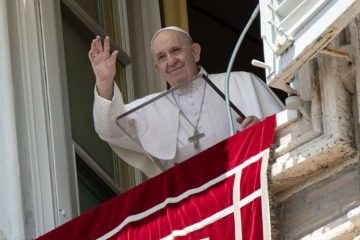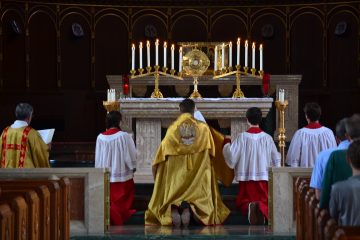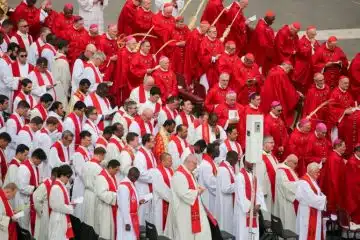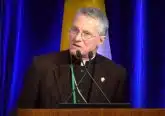With release of sex abuse report, National Review Board cautions against complacency
CNA Staff, Jun 26, 2020 / 03:00 am MT (CNA).- The head of the National Review Board has called for increased action to fight sex abuse and avoid complacency, following the release this week of a report on sex abuse in the U.S. Catholic Church.
“We know that many current bishops have seriously confronted clerical sexual abuse, which is borne out in the Annual Report,” said Francesco C. Cesareo, chairman of the National Review Board. “Yet, the Report also evidences areas in need of improvement that will necessitate an on-going effort in addressing this issue in a way that will require courageous leadership, as well as an openness to the co-responsibility of the laity in responding to this ever-present crisis.”
He warned that even limited failures can present a significant problem for the Church in the U.S. The National Review Board is calling for a more in-depth audit and updates to the Charter for the Protection of Children and Young People, he said.
“We continue to see the failure to publish reporting procedures in the various languages in which the liturgy is celebrated; poor recordkeeping of background checks; dysfunctional Diocesan Review Boards; lack of a formal monitoring plan for priests who have been removed from ministry; failure to update policies and procedures in light of the 2011 Charter revisions,” he said.
While these problems are not widespread, they do recur and are evident in 25% to 30% of dioceses. Cesareo said this indicates “lack of diligence that puts children’s safety at risk.”
“The apparent resistance by some parishes and schools to provide safe environment training places children at greater risk,” he said. “Although dioceses continue to do good work in creating cultures of protection and healing, the fact remains the Church’s efforts will be measured based on the weakest links. If one diocese is at risk, the whole Church is also at risk.”
The annual report on Findings and Recommendations on the Implementation of the Charter for the Protection of Children and Young People was released June 25 by the U.S. bishops’ Secretariat for Child and Youth Protection. It is the seventeenth report since the charter was implemented in 2002.
The Rochester, New York-based consulting firm StoneBridge Business Partners conducted the audit. The Center for Applied Research in the Apostolate conducted a survey included in the report.
The audit found three instances of non-compliance with the charter: the Oakland diocese failed to evaluate a visiting priest’s background and there were a non-functioning review boards in both the Ukrainian Archeparchy of Philadelphia and the St. Thomas Syro-Malabar Catholic Diocese.
Additionally, non-participants in the audit were the Eparchy of St. Mary Queen of Peace, the Eparchy of St. Peter the Apostle, and the Eparchy of St. Nicholas of Chicago.
Out of more than 37,000 diocesan and religious order priests, there were 37 allegations involving current year minors, of which 8 were substantiated and the priests were removed from ministry. Twelve allegations are still under investigation, 7 were ruled unsubstantiated, 6 were unable to be proven. Another three have been referred to religious orders, and one was referred to another diocese.
Archbishop Jose Gomez of Los Angeles, president of the U.S. Conference of Catholic Bishops, said in the report’s preface that all of these allegations were reported to law enforcement. He said the numbers indicate that new cases of sex abuse by clerics are rare.
“Of course, every case is one too many, and we remain vigilant and determined to prevent this evil,” the archbishop said. He stressed the efforts to implement policies and programs to protect young people and create safe environments in parishes, schools and other Catholic ministries.
Hundreds of thousands of adults have been trained to prevent abuse and to report it, while leaders have been put through extensive background checks, Gomez said. Dioceses have implemented strict reporting requirements, and work closely with law enforcement to report alleged abuse and to remove accused abusers from ministry, he said.
“My brother bishops and I want to apologize to all those who have endured abuse at the hands of someone in the Church and we want to express our pastoral commitment to helping every victim-survivor find healing and hope,” the archbishop said.
“From out of the failures of our past, Catholic dioceses across the country have worked hard to put in place policies and programs to protect young people and to create safe environments in our parishes, schools and other ministries.”
The report concerns the audit period of July 1, 2018 to June 30, 2019. In that time, 4,220 adults brought forward 4,434 allegations. This is a significant increase in allegations, which the report attributed in part to additional allegations received in the wake of lawsuits, compensation programs, the reviews of clergy files, and bankruptcies.
By comparison, last year’s report for the 2017-2018 audit period said 1,385 adults reported 1,455 new allegations, the vast majority of which concerned historical instances of abuse. Those numbers represent a marked rise over the 2016-2017 reporting period. Last year’s report attributed the escalation to the state-wide adoption of Independent Reconciliation and Compensation Programs by Catholic dioceses of New York State.
The latest reporting period followed the June 2018 revelations that the deeply influential ex-cardinal Theodore McCarrick, the former Archbishop of Washington, had for decades sexually abused teen boys and young men, including seminarians. A Pennsylvania grand jury report released later in 2018 also examined sexual abuse by Catholic clergy.
About 80% of newly reported victims of diocesan clergy were male, while 20% were female. The report said 59% of alleged abuse began when the victim was aged 10-14, while 22% involved victims aged 9 or under.
Among the newly reported allegations, abuse by diocesan clergy peaked in 1970-1974. According to the report, 50% of alleged abuse occurred or began before 1975, 45% between 1975 and 1999, and 5% after 2000.
About 43% of alleged perpetrators in diocesan clergy did not have prior allegations against them, while 57% did. Ninety percent of alleged diocesan offenders are deceased, already removed from ministry, already laicized, or missing. Forty priests or deacons identified as alleged abusers in 2019 were permanently removed from ministry.
Diocese and eparchies that responded to the survey reported over $281 million in costs related to sex abuse allegations in the 2018-2019 period. About 71% of this went to settlements for victims, while 15% went to attorney fees. Religious institutes, which are handled in a separate category, paid over $41 million. Besides settlements and legal expenses, these costs include support for offenders and other payments to victims for purposes including therapy, living expenses, or legal expenses.
In last year’s audit period, dioceses and eparchies provided outreach and support to 1,138 families who had newly reported abuse, while they provided continued support to 1,851 survivors and their families who had previously reported abuse.
Catholic churches and organizations conducted over 2.6 million background checks on clergy, employees and volunteers. More than 2.6 million adults and 3.6 million children and young people were trained in abuse awareness and reporting.
In February 2019, Pope Francis held the first-ever global summit on protecting minors in the Church. In May 2019, the pope issued new norms in the document “Vos Estis,” aiming to hold bishops and religious superiors accountable when they are accused of abuse or when they are accused of mishandling abuse allegations.
Cessario said the promulgation of Vos Estis and U.S. bishops’ efforts to enact it “signaled an important and positive response” in the wake of revelations about McCarrick.
“Nonetheless, subsequent revelations of episcopal wrongdoing, the establishment of compensation plans for victims, the announcement of new grand jury investigations in several states, the filing of new lawsuits regarding abuse, and a growing desire among the laity for greater involvement in addressing this issue has led many to question whether the audit is sufficiently adequate to determine if a culture of safety within dioceses has taken root,” he said.
Cessario said the National Review Board has called for a “more in-depth audit,” as well as “a further revision of the Charter that will incorporate new practices, such as parish audits, offering greater assurance of compliance.”
Deacon Bernie Nojadera, executive director of the U.S. bishops’ Secretariat of Child and Youth Protection, wrote a Feb. 28 letter included in the report. He reflected on how the abuse crisis has affected Catholics’ faith.
“For some, this crisis has strengthened their faith and resolve – has confirmed the importance of keeping the faith and ultimately relying on the mercy, goodness, and plan of God,” he said. “For others, this crisis has destroyed lives and faith and trust in God. The theological implications point to the need to reconnect appropriately with God and with each other. Understanding what is happening in the Church and Her response is part of the solution.”
Nojadera noted the need to develop and maintain “right relationships” with young people and the vulnerable to help the Church learn and grow amid the sex abuse crisis.
“Only by promoting a culture of protection and healing can we prevent the evil of sexual abuse and bring true healing to those affected by this crime,” he said, emphasizing the need for continued vigilance.
The U.S. bishops’ statement on the report’s release said that the audit and the continued application of zero-tolerance policies are “two important tools in the Church’s broader program of creating a culture of protection and healing that exceeds the requirements of the Charter.”













